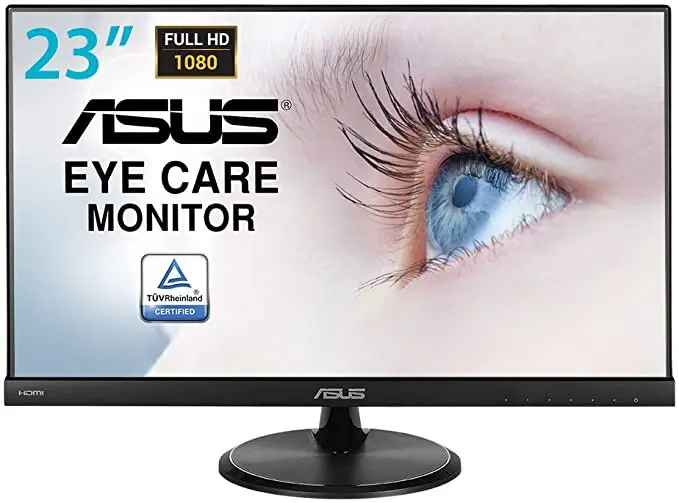
Today we will look at the monitor VC239HE from Asus from the year 2015. Within this article, we will first take a closer look at the most important feature of a monitor -the display-, then the design, and in the next section we will go into the features of the monitor. Of course, power consumption, certifications, connectivity and other important details will also be considered.
Display
Videos and/or other applications can be displayed on the monitor's 23 inches ( 58.4 cm on the diagonal). As already known, two monitors with different outer dimensions can have the same screen diagonal. In the case of the monitor VC239HE , we find an aspect ratio of 1.778 to 1. This means that for every 1 pixels in height, 1.778 pixels in width are added. For comparison: A classic CRT monitor had an aspect ratio of 4:3. Around 84.9 % of the front surface of the monitor consists of the display, while the rest is made up of screen edges that cannot display images. If you want to place several monitors next to each other, it is advisable to prefer those with narrow edges. The display is a IPS panel. The panel has a resolution of 1920 x 1080 px. The pixel density is 95 ppi. The pixel pitch is 0.265 mm. The continuous possible brightness specified by the manufacturer Asus is 250 nt. The panel is illuminated by W-LED. The built-in panel ensures stable color reproduction of the image, even at deviating viewing angles, by means of its 178 ° (horizontal) viewing angle. Asus promises stable color reproduction moreover within a 178 ° vertical angle. The refresh rate is horizontally seen at the VC239HE 30 khz to 80 khz. Vertically, however, the image renews at a minimum rate of 56 hz up to 76 hz. The analog refresh rate of this monitor is 30 khz to 80 khz. The frame rate in the analogue range is vertical at the VC239HE 56 hz to 76 hz. The minimum response time of the monitor is ms. The display panel is Anti-glare/Matte (3H).
Color representation
The panel has a bit depth of 8 per color channel, but what does that mean? The number of bits determines how many colors can be encoded for the individual pixels of the display. For an 8-bit panel, for example, this is 256 different colors (2^8 = 256). However, since we usually display three different colors per pixel at the same time, in theory about 16 million (256^3) different colors are possible by mixing the three pixels. A 10-bit panel could even display a billion colors. According to the manufacturer, the coverage of the NTSC 1953 color space is 72 %.
Contrast ratio
Contrast ratio is a common measurement used to represent the maximum relative differences in brightness between black and white. It describes the ability of a screen or projector to produce a high-contrast image and is the quotient of the maximum and minimum displayable luminance. The higher the values are away from each other, the stronger the quantitatively seen difference between black and white is set up, which in turn results in an improved image quality. This monitor from Asus has a static contrast ratio of 1000 : 1 , according to the manufacturer. In contrast to the static contrast ratio, the dynamic contrast ratio changes the brightness of the panel itself in addition to the difference measurement from black to white. In addition to the difference between the brightest and the darkest pixel, the backlight is thus changed. Since the brightness of the panel may not be able to be adjusted exactly to a single pixel, a so-called halo effect is possible. The value of 80000000 : 1 of dynamic contrast ratio for the monitor VC239HE cannot provide any information about the severity of the halo effect here. Therefore, it is more useful to compare the static contrast ratio.
HDR
The monitor supports all HDR modes listed here:
screen design
For the installation of the monitor, a space requirement of approximately 32.2 cm in height, 53.3 cm in width and 4.5 cm in depth is to be assumed.
The size of the VC239HE on the desk is likely to be particularly relevant for most users. Asus specifies a space requirement of 38.3 x 53.3 x 19.9 cm (HxWxD) with the included stand. If you want to place the monitor on a table or even transport it, you should expect a weight of 3.4 kg with the stand screwed in. Without stand, the monitor weighs 3 kg. Speaking of weight without a stand and thus wall or table mounts. The monitor supports a Vesa mounting.
Rotate, tilt and swivel
The monitor from Asus cannot be rotated. The monitor cannot be swiveled. This feature could be retrofitted with a third-party stand. The tilt of the monitor VC239HE can be individually adjusted to optimize the viewing angle and increase comfort during use. The monitor can be tilted forward by 5 degree.
Ports
The monitor can be connected via 1 VGA ports.
Features
- The display/monitor supports Frame Rate Compensation.
Power consumption
The average consumption was given by Asus as 16 w. In standby mode, the device consumes approximately 0.5 w. When switched off, on the other hand, the monitor consumes only 0.5 w. The monitor can be operated on a 110v power supply. The monitor can be operated on a 220v power supply. The power grid has to supply a frequency of 50 hz to 60 hz.
Packaging
The monitor is packaged in a cardboard box measuring 44.8 x 58.9 x 12.1 cm (height x width x depth). The box together with the monitor weighs about 5.2 kg.
Further information
- 100x100
- 1.4

